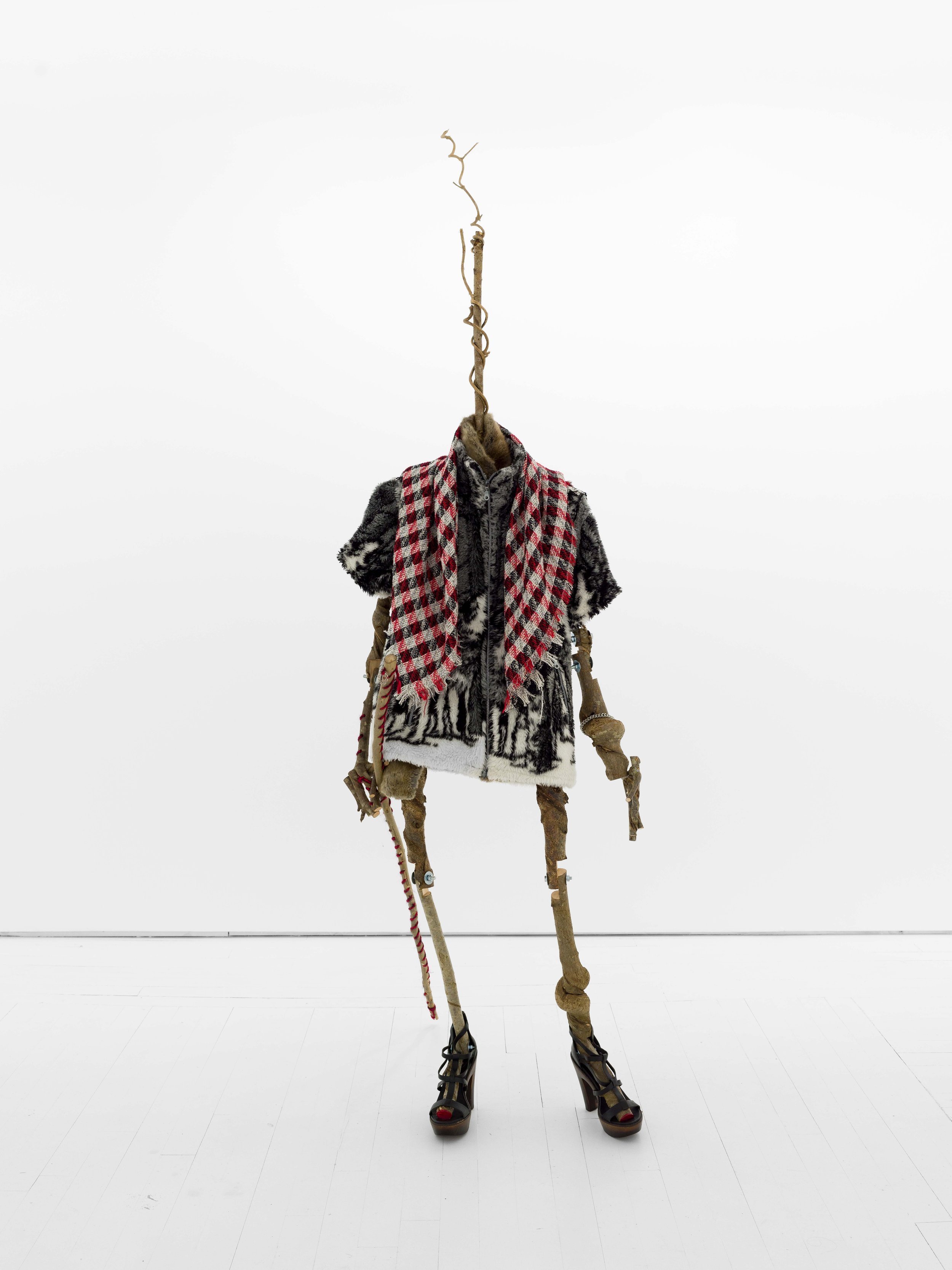Oh, What a World
Jamiu Agboke, Andrew Cannon, Daniel Gibson, Haley Josephs, Rasmus Myrup, Nikholis Planck, Anjuli Rathod & Kelsey Shwetz
January 13 - February 25, 2023
Jack Barrett Gallery is pleased to present Oh, What a World a multidisciplinary group exhibition featuring a selection of works by Jamiu Agboke, Andrew Cannon, Daniel Gibson, Haley Josephs, Rasmus Myrup, Nikholis Planck, Anjuli Rathod, and Kelsey Shwetz, on view from January 13 to February 25.
Nature and the elemental has increasingly been taken to task in various fields of discourse and practice in the past two decades, with growing concerns over the environment and how humans avoid violence when cohabiting with the non-human. That violence can be active but also passive, particularly in the latter when we are divorced from environments outside of the urban. In the past three years, isolation and state-sanctioned containment have compelled many to not only appreciate but to need “nature,” particularly for its aesthetic, spiritual, and corporeal benefits.
The artists in Oh, What a World have attended to the spatial complexities of nature and the elemental, making use of diverse epistemologies and methodologies in their works. In Daniel Gibson’s work, vibrant, painterly flowers embody how the artist contends with the complexities of migration, each flower representing a migrant who travels northbound from south of the California border. “Flowers for AG” (2022), a dedication painting for Gibson’s late grandmother, contains symbolism that offers clues to a deeper, sociopolitical meaning. In the center of the foreground, water drops from a blue, azure flower, signifying the importance–and scarcity–of water for the migrants who make this dangerous passage north.
Anjuli Rathod also grapples with diasporic concerns, mobilizing her painting practice to represent what happens when language fails to stage the diverse psychical planes of existence. Her work can also be read in tandem with Haley Josephs, whose paintings address the stages of human life and the psychological transformations that arise therein. Existential rituals are a throughline in their work, with solitude represented as a practice that can unearth truths related to mourning and grief, whether that loss is embodied in a human or a temporal form.
Oh, What a World also features works that endeavor to fill crucial gaps of recorded knowledge. In recent years there has been a discursive, cultural, and scientific emphasis on fungi and its crucial ecological impacts. Once a neglected feature of ecological discourse, more scholarly and recreational interest has materialized. Andrew Cannon’s practice involves extending the discourse through artistic processes, with his sculptural landscape paintings, or reliefs, that attend to mycology, the scientific study of fungi.
With a geographical and historical focus on Norse mythology, Rasmus Myrup seeks gendered, sensual, and sexual interventions with his sculptures and installations, re-directing our gaze to counter-narratives and revisionist histories that remain obscured amid the contours of heteronormativity. “Völva [Vølven]” (2020) introduces the spectator to a Völva, a Norse witch and seeress, once a venerable figure who was also feared for her prophetic power.
Historiographical correctives are also a concern for Kelsey Shwetz. Her works suggest the residue of human trace and yet places flora, fauna and natural forms as central narrators. From this vantage point, the scenery is almost ominously unperturbed, the compositions vibrating between traditional landscape and surrealism. Shwetz lithely mines the margin between identification and estrangement with these hyper-real landscapes, presenting work that reminds us of the parts of our world we stand to lose by ecological indifference.
The works in Oh, What a World do not constitute a monolith, but the artists here share a commitment to nature and its relationship to human consciousness in their representations or mediums. One of the artists, Nikholis Planck, whose work spans painting, drawing and performance, is notable here for his drawings that materialized through his visits to the Green-Wood Cemetery in Brooklyn. Equally atmospheric and abstract are the paintings of the emerging artist Jamiu Agboke, whose two paintings in the exhibition, “Swimmer” (2022) and “Float” (2022), evoke the dynamism of water, the non-human natural entity that, like all processes of the natural world, can maim but also cure.
– Kristen Cochrane
Daniel Gibson Flowers for AG, 2022 Oil on canvas 36 x 47 inches
Andrew Cannon Mountain Laurel Platter, 2022 Polymer gypsum resin, wood, epoxy putty, acrylic paint, watercolor 50 x 36 x 6 inches
Anjuli Rathod Transfer of Energy, 2022 Acrylic, watercolor and flashe on canvas 24 x 20 inches
Kelsey Shwetz Pluck, 2022 Oil on canvas 32 x 28 inches
Haley Josephs Dream Spiral Kitten, 2022 Oil on canvas 74 x 96 inches
Rasmus Myrup, Völva [Vølven], 2022, Rowan wood, honeysuckle, repurposed fur, fleece jacket, cashmere, wound wool, wooden structure, heels, jewelry, hardware, Dimensions variable
Andrew Cannon Wisconsin Flag, 2022 Polymer gypsum resin, wood, epoxy putty, plaster, acrylic paint, watercolor 19.5 x 19.5 x 2 inches
Jamiu Agboke Float, 2022 Oil on canvas 18 x 16 inches
Kelsey Shwetz Ruin (Lantern), 2022 Oil on canvas 54 x 50 inches
Nikholis Planck Groundskeeper/Gate House, 2022 Water soluble oil on conjoined wax paper 25.5 x 28 x 1.5 inches, framed
Nikholis Planck Rock Wall, 2022 Water soluble oil on conjoined wax paper 18 x 20.5 x 1.5 inches
Nikholis Planck Sea Wall, 2022 Water soluble oil on conjoined wax paper 23 x 28.25 x 1.5 inches, framed
Jamiu Agboke Swimmer, 2022 Oil on canvas 16 x 20 inches
Rasmus Myrup, Raven of the Slain [Valravn], 2021, Model Concorde, foraged feathers, Dimensions variable
Andrew Cannon Oak Flag, 2022 Wood, polymer gypsum resin, pigment, watercolor 20 x 17 x 2.5 inches



















![Rasmus Myrup,
Völva [Vølven], 2022,
Rowan wood, honeysuckle, repurposed fur, fleece jacket, cashmere, wound wool, wooden structure, heels, jewelry, hardware,
Dimensions variable](https://images.squarespace-cdn.com/content/v1/62b359f433ad9c4758ab36ae/3a25f404-6741-4236-94ed-6db59009539a/Myrup%2C+Volva-1.jpg)







![Rasmus Myrup,
Raven of the Slain [Valravn], 2021,
Model Concorde, foraged feathers,
Dimensions variable](https://images.squarespace-cdn.com/content/v1/62b359f433ad9c4758ab36ae/b1b6cf44-3839-4cb2-9865-b2e349751f3a/WEB+Sk%C3%A6rmbillede+2022-12-08+kl.+19.59.jpg)
